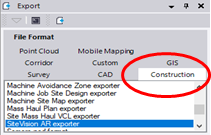

To be able to run macros you need at least a "Survey Advanced" licence of TBC. Now you can also use the Surface "Edge Breakline" properly, and manipulate it, to create an inner/outer continuous line if necessary. Small " Maximum Edge Length" don't always work as expected, but in this case it does. Then select the surface and open the properties of it.Ĭhange the "Maximum Edge Length" to something small, smaller then that gap in your triangles I showed you above. It contains 3DFaces, which you can easily use to create a surface. That file also includes the manipulated closed inner and outer breakline. I also exported the XML surface as DXF, which gives you 3D faces. I manipulated the breakline that came with the point/line XML definition and created a closed inner and outer boundary, a true void. I exploded the XML triangle surface and used those breaklines to created a new surface. Or exporting the surface as DXF, which gives you 3D-faces you can reimport and use again as base for another surface. That's also one possibility to create a "void" inside a surface.Ĭreating a "Surface Edge Breakline" on the XML-Triangle surface doesn't work for some reason, I also end up with a lot of small fragments.But there are ways to get around that. The XML has one border only, and the surface hasn't really a hole, but a small slim gap in it. The point/line version will give you a proper edge breakline though. You should import both versions, BUT only use the triangle based version, as the point/breakline version doesn't represent your surface properly. (Apart from some flags for crossing lines, or vertical faces) It was just the XML, I don't see a CAD file in that folder.Īfter dragging the XML into TBC it looks already ok. I just had a look at the file you uploaded to me.

If the inner line is a closed boundary, or even a set of lines that collectively form a closed area, then you can also change them to Linestrings (use Convert to Linestring command) and then select them all and set their properties to Sharp and Texture Boundary and then you can apply a Null texture in the "Hole" to eliminate the triangles out to the boundaries you have defined. You can use Edit Linesting to check for those as needed. If the source data came from an Engineer - you need to check for normal CAD errors - lines that cross over, have gaps between end points etc and make sure that there are no crossover loops in the lines etc. You can also use Join command to join disconnected pieces into a continuous line for either one of the two lines.

The inner line can be created using the Track region outline command. The outside one as Ronny stated can be created using the Create Surface Edge Breakline command. This should create you the surface with the hole in the middle.Īs Ronny says - if your surface has lines but they are not continuous lines in a closed loop, then you need to create the closed loop lines to be used as boundaries. Then add / Remove Surface Boundaries and add the Inner and Outer lines as surface boundaries. You create your surface model using the two lines and it will triangulate the entire area. To create a surface with a hole in it requires that you have an Outer Boundary line (the outside line of your two lines) and an inner boundary line (the inner line of the two lines).


 0 kommentar(er)
0 kommentar(er)
